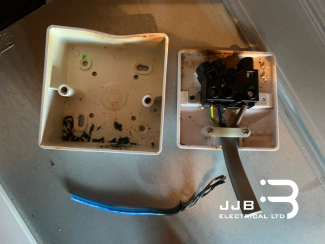We rant on and on about the importance of having your home regularly inspected, tested and EICRs, but on average week get 3 to 4 calls from new customers asking us to investigate either a loss of power, a light stopped working, a dodgy socket or a strange hissing sound coming from a light switch.
So, what's the main cause of this issue, I hear you ask?
Well nine times out of ten it’s due to a loose connection. A loose connection in your home can be potentially dangerous, if unnoticed they can lead to electric shocks or even house fires!!
Other issues include:
Overheating: When a connection is loose, it creates resistance in the circuit, which generates heat. Over time, the heat can cause damage to the insulation around wires or components, increasing the risk of short circuits or fires.
Electrical arcing: Loose connections can also cause electrical arcing, which is when electricity jumps across a gap in a circuit. Arcing can cause damage to wires and components, and can create a spark that could ignite flammable materials. Well, there’s the house fire!!
Reduced efficiency: Loose connections can decrease the efficiency of the circuit, causing it to work harder to achieve the same level of output. This can lead to increased energy consumption, higher utility bills, and reduced lifespan of equipment. Heres the hole in the pocket.
Electrical shocks: Loose connections can also increase the risk of electrical shocks, which can be dangerous or even fatal. Electrical shocks occur when electricity travels through a person's body and can cause burns, muscle contractions, and heart arrhythmias.
Overall, it's essential to ensure that all connections in electrical circuits are secure and properly tightened. Loose connections should be identified and fixed as soon as possible to prevent potential hazards.
So, what to look and listen out for:
Before plugging in any appliance, always have a quick look over the lead and the plug, check for signs of damage, signs that the lead has been over stretched or signs of burning.
If a lead is damaged, it could be a shock risk. Either have appliance repaired or replace it.
If a lead has been over stretched, pulled away from the plug and you may be able to see those inner cores, poor connections will be present and could be a shock risk, so either fix it of throw it.
Now for the burning one, if the plug top has signs of burning it could be overload, faulty or have loose connections within.
Always check your socket outlets for signs of burning or damage before use. If you notice burning on a socket outlet, it's important to take immediate action.
Here are some steps to follow:
- Turn off the power: First, turn off the power to the affected outlet by turning off the circuit breaker.
- Inspect the outlet: Carefully inspect the outlet for any signs of damage or burning, including discoloration, charring, or melted plastic. If the damage is severe, do not attempt to use the outlet.
- Check for loose connections: If the outlet appears to be intact, check for loose connections by gently wiggling the plug in the socket. Loose connections can cause arcing, which can lead to burning and other damage.
- Contact a professional: If you suspect that the burning is due to a faulty wiring or overloaded circuit, or if you are unsure of how to proceed, contact a registered electrician to assess and repair the problem.
Ignoring burning on a socket outlet can lead to serious hazards, including electrical shock, short circuits, and fires. It's important to address the issue promptly to prevent potential danger and damage to your property.
Lastly if you can smell burning and can hear popping and cracking, turn your power off ASAP and call an electrician straight away. If you’re concerned about your home electrical system give us a call on 01992 276087.


